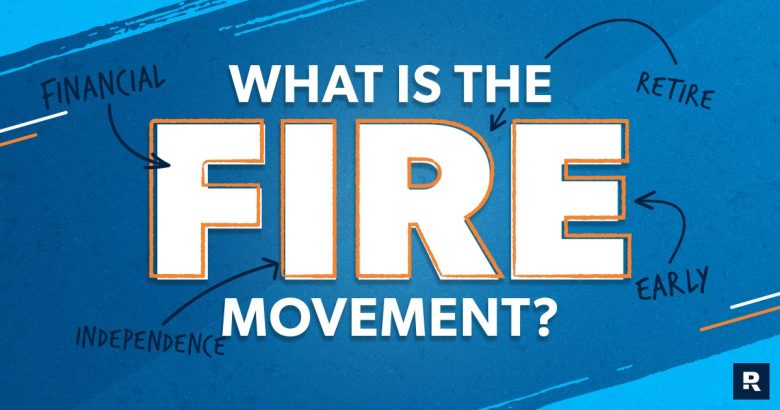The thought of retiring early and enjoying life how and when you want is a strife for a lots of people. As more people try to achieve financial freedom and take a break from the mundane 9-to-5 work routine, the FIRE (Financial Independence, Retire Early) movement has become increasingly popular in recent years. The FIRE movement focuses on saving and investing a lot early in life so that you can achieve financial independence and retire decades before the conventional retirement age as teenagers or young adults.
Followers of FIRE seek to escape financial burdens and concentrate on the aspects that are most valuable to them by strategically cutting costs and amping up passive income. But is it possible for everyone to retire early? How can you incorporate the principles of FIRE into your life? It will focus on explaining the FIRE movement, its different approaches, its advantages and disadvantages, and how one can begin their path toward financial independence and early retirement.
What is the FIRE Movement?
The FIRE movement is a financial lifestyle centered on achieving financial independence by saving aggressively, investing wisely, and living a frugal life. The idea is to accumulate wealth to the point where you do not depend on a traditional job. Financial independence is achieved by having a high savings rate (usually 50% or more), investing in passive income assets, and keeping expenses low.
The movement strives to achieve a level where one’s savings and investments can sustain their living expenses forever. This enables individuals to “retire” as early as their 30s, 40s, or 50s instead of waiting for the retirement age of 65. However, the movement is not just about quitting work altogether, but rather gaining the freedom to pursue their passions—be it hobbies, traveling, or even part-time work—without financial burdens.
Different Types of FIRE Strategies:
People do not homogeneously practice the FIRE movement. Different variations exist to accommodate diverse financial circumstances and lifestyle choices.
FIRE, or Financial Independence and Retiring Early, has many variations, each catering to a different level of spending and lifestyle before and during retirement. With the Traditional FIRE, also called the standard approach, individuals save intensely, investing in either index funds or real estate, leading to early retirement living off their fully funded nest egg. This requires disciplined financial planning, living within stringent budgets.
There’s the Lean FIRE that caters to people who wish to retire at an earlier age and lead a minimalist lifestyle. It best suits individuals who require very little to live, as this option comes with the lowest expenses and would be ideal for anyone seeking a low income while retired.
For those who desire an earlier retirement but still want to uphold a higher standard of living, there’s Fat FIRE. This option requires accumulating wealth and having reliable passive income streams to support a luxurious lifestyle without straining spending.
There’s Barista FIRE, a mixture of achieving financial independence yet choosing to only work part-time, or on passion projects, allowing for extra income. This provides more financial flexibility while still relishing in the perks of early retirement.
In essence, Coast FIRE is a step beyond basic FIRE, or retirement planning, wherein individuals make aggressive savings during their early working years and subsequently relax their investment activities, allowing the savings to grow with time. People can continue working and not suffer financially, whilst knowing that they are on course for a comfortable retirement later on.
Steps to Take: Financial Independence and Early Retirement
Reaching the FIRE goal requires commitment, strategic planning, and strict self-discipline over time. The very first step entails far evaluating your current financial situation, covering income, expenditure, debt, and savings. Monitoring your spending is essential, as is identifying potential cost-cutting areas, in optimizing your savings rate. It’s a no-brainer that a higher savings rate will lead to quicker financial independence and freedom.
Effective investing is another staple action of the FIRE movement. Most followers of the FIRE approach invest in low-fee index funds, which offer diversification as well as growth in the long-term. Others also put money into rental properties, stocks that pay dividends, or secondary jobs that provide passive income. The goal here is to build a portfolio that can offer enough returns to meet living expenses without the need for active work.
Lifestyle inflation also has to be curbed. The majority of people spend more when they earn more, but FIRE advocates strive to maintain a lower spending lifestyle iin theirgrowing income. Spending less than what you earn frees up resources that allow you to save more, enabling you to reach financial independence much faster.
Another key factor is increasing one’s income. While these strategies are helpful, boosting your income from side gigs, freelancing, promotional opportunities at work, or starting a business can help improve savings a whole lot. A significant number of FIRE adherents have multiple income-generating activities to accelerate wealth accumulation.
This principle is especially common among practitioners of FIRE. It states that in retirement, you should be able to withdraw 4% of your total investment portfolio every year without the risk of depleting your funds. Based on this rule, followers of FIRE calculate their FIRE number by multiplying their annual expenses by 25. For instance, needing $40,000 to live a comfortable life means you will require a $1 million portfolio.
Challenges and Downsides of the FIRE Movement:
Even though it’s tempting to think of the FIRE movement as a one-way ticket to financial freedom and early retirement, there are still a few challenges one might face along the way. One such hurdle could be the immense amount of self-discipline and sacrifice it takes to achieve FIRE goals. Achieving a 50% saving rate or more demands meticulous bookkeeping and cutting down on everything enjoyable.
Another major concern to take into account is market volatility. Since FIRE is heavily dependent on investment income, economic slowdowns can greatly affect portfolio value and financial stability. Those who opt for FIRE need to be able to weather the ups and downs of the market on top of having alternative plans ready.
For those planning to retire in their 30s or 40s, especially without employer-sponsored health insurance, healthcare costs can pose a daunting problem. With taking medical expenses into consideration, FIRE becomes increasingly complex when it comes to ensuring adequate health coverage meant for long-term financial security.
For someone considering early retirement, boredom or lack of purpose can pose as another challenge. A great number of people are left feeling unfulfilled socially and professionally, as a large portion of their social life and their job is based in the office. Without financial independence, transitioning to early retirement requires careful planning in order to have a meaningful and fulfilling lifestyle.
Lastly, unplanned expenses or lifestyle changes can affect financial goals. Following the progress towards FIRE needs a flexible and adaptable approach to deal with unanticipated situations such as family emergencies, economic changes, or shifting personal goals over time.
Is It A Good Fit For You To Choose FIRE?
Determining whether the FIRE movement makes sense as a solution depends on an individual’s financial objectives, risk appetite, and preferences. For people who cherish financial freedom and are willing to make some compromises for an early retirement, FIRE can be an enabling journey to liberation. While rewarding, FIRE additionally demands commitment, discipline, and meticulous long-term financial strategizing.
If you derive joy from your work and consider your career as part of your identity, a more palatable version of FIRE, like Barista FIRE or Coast FIR, E might serve you best. These concepts enable achieving financial independence without sacrificing one’s freedom to partake in purposeful work on one’s terms.
Even if early retirement isn’t your target, principles from the FIRE movement, like aggressively saving, smart investing, and living within your means, are beneficial to everyone. These habits can enhance life for all people, regardless of when they intend to retire, by providing greater financial security, less stress, and an increased number of life choices.
Conclusion:
The FIRE movement provides individuals with a path towards financial independence alongside total early retirement. This gives followers the freedom to escape from the pull of conventional work and live on their terms. Those who follow FIRE strive to achieve financial independence decades before the usual retirement age by saving heavily, investing wisely, and adopting a frugal lifestyle.
Although the movement has some challenges, like market risks, healthcare expenses, and lifestyle changes, the fire principles can aid anyone looking to gain control over their finances. If you aim for early retirement or simply want to strengthen your financial situation, strategies from FIRE will allow you to build a secure and fulfilling future. While the path toward financial independence demands discipline and patience, the challenges are rewarding for those who are willing to put in the effort.
FAQs:
1. How much money do I need to retire early with FIRE?
The amount will be 25 times your annual spending with the 4% withdrawal rule.
2. Can I achieve FIRE without living an extremely frugal lifestyle?
Yes, “Fat FIRE” is one version that allows for a higher lifestyle. Additional income and reasonable spending could help, too.
3. What happens if I run out of money after retiring early?
Most FIRE retirees have safety nets, like side hustles or part-time work, along with adjusting their withdrawal rate to prolong savings.
4. Is FIRE only for high-income earners?
No. People across different income levels can achieve FIRE as long as there is a healthy spending rate, savings, and strategic investments.
5. Do I have to quit working completely after achieving FIRE?
No, working on passion projects, freelancing, or even building a business while financially independent is common among FIRE followers.




